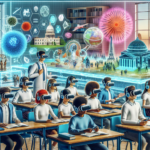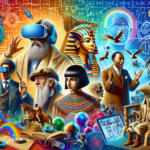Transforming Employee Training: The Power of XR in Workforce Development 🌟
The Future of Learning is Here: Understanding XR
As industries continue to evolve in the digital age, employees need to keep pace with rapid changes in technology, skills, and workflows. Enter XR—Extended Reality—which encompasses virtual reality (VR), augmented reality (AR), and mixed reality (MR). This innovative technology is not just a tool for gaming or entertainment; it’s set to revolutionize employee skill development in unprecedented ways.
What Makes XR a Game Changer for Workforce Training?
XR technologies offer immersive experiences that engage users in a way traditional training methods simply cannot. Here’s why integrating XR into workforce training is a brilliant move:
- Immersive Learning Environments: XR creates realistic simulations where employees can practice skills in safe, controlled settings.
- Enhanced Engagement: Interactive elements capture attention and enhance participation compared to standard training sessions.
- Real-Time Feedback: Participants receive immediate insights into their performance, allowing for more effective learning adjustments.
- Accessibility: Remote learning possibilities mean that employees can train from anywhere, breaking geographical barriers.
XR in Action: Real-World Applications
To fully appreciate the impact of XR in workforce training, let’s explore some industries where this technology is making significant strides:
Healthcare: Saving Lives Through Simulation
In the healthcare sector, XR delivers training that can truly be lifesaving. Surgeons can practice complex procedures in a virtual environment without real-world consequences. Imagine a young doctor performing heart surgery with haptic feedback allowing them to “feel” the procedure as if it were real. This method not only enhances skills but builds confidence—essential qualities when lives are at stake!
Manufacturing: Perfecting Production Skills
Manufacturers are increasingly relying on XR to train workers on complex machinery. Using AR, employees can superimpose digital information onto physical equipment. This method helps in troubleshooting, maintenance, and operations, ensuring that team members can operate machinery safely and efficiently. Worker error rates are significantly reduced, leading to increased productivity and safety.
Retail: Elevating Customer Service Training
In the retail space, AR can simulate various customer interactions, allowing staff to practice service skills and product knowledge in realistic settings. Employees can receive real-time suggestions on how to handle challenging situations. XR-powered training provides a safe environment to learn from mistakes without the risk of losing sales or alienating customers.
Benefits of XR Training for Employees
Integrating XR into training protocols offers a multitude of benefits for employees, paving the way for professional growth and job satisfaction. Here are a few standout advantages:
- Cost-Effective: While initial investments may be significant, the long-term savings related to training costs, error reduction, and improved performance are substantial.
- Personalized Learning: XR can cater to various learning styles, offering tailored experiences that suit individual needs.
- Increased Retention: Learning through experiences leads to better retention of skills and knowledge since employees actively engage with the material.
- Agility in Training: Organizations can quickly update training modules in XR environments to reflect new information or procedures, ensuring employees are always up-to-date.
Implementing XR Training: Steps for Success
For organizations looking to integrate XR into their training programs, here are some practical steps to ensure success:
1. Evaluate Your Training Needs
Before implementation, carefully assess your organization’s training requirements. Identify key skills where XR could provide the most value. This step will help you focus your investment where it matters.
2. Choose the Right Technology
Not all XR technologies are created equal. Determine whether VR, AR, or MR is best suited for your training objectives. Consider factors such as accessibility, user experience, and alignment with your learning goals.
3. Create Engaging Content
Your XR content must be compelling and reflective of real-world scenarios. Collaborate with training experts and content creators to develop modules that are not only informative but also engaging.
4. Pilot the Program
Before full-scale implementation, conduct a pilot program with a selected group of employees. Gather feedback to refine the program before rolling it out organization-wide.
5. Measure and Adapt
Utilize analytics and performance metrics to gauge the effectiveness of the XR training. Be prepared to adjust your approach based on feedback and learning outcomes to optimize the training experience.
Facing the Challenges: What to Expect
While the benefits of XR are clear, organizations must also prepare for potential challenges:
- Resistance to Change: Employees may be hesitant to adopt new technology. Providing training and showcasing the benefits can help ease transitions.
- Technical Issues: As with any tech-based solution, issues such as software bugs or hardware malfunctions may arise. Invest in a robust support system to resolve these swiftly.
- Content Development Costs: Creating high-quality XR content can be expensive. Budget accordingly and consider partnerships that can help mitigate costs.
The Future is Bright: Embrace XR for Training 🌈
The shift toward XR in workforce training signals a significant transformation in how organizations approach employee development. By embracing this innovative technology, companies not only enhance training effectiveness but also create a culture of continuous learning, innovation, and adaptability.
As we venture deeper into the digital era, the tools and technologies we employ in workforce training will define the success of employees and organizations alike. Get ready to harness the power of XR—it’s an exhilarating journey toward a brighter future for skills development!




0 Comments